










There’s so much fresh produce from farms around Malta and Gozo, what to cook for Taste&Flair’s May issue was an easy choice. Michael Diacono picked out the lowly cauliflower to show that “with a bit of thought, any recipe can be fun and super tasty. Making vegetables and pulses the main star of any meal does not necessarily lead to bland eating.” Claire Borg picked field-grown aubergines as her key ingredient: “they’re so versatile and I enjoyed the challenge of coming up with different ways of preparing them.” In a food and memoir feature, Seghar Setaher reflects on her culinary journey from Iran to Italy and the many parallels that link Middle Eastern and Mediterranean food cultures, and how ingredients and recipes are transformed through the immigrant experience. Andrew Azzopardi joined some 6000 other wine specialists from around the world, tasting around 250 young wines from the 2022 vintage. The features in our architecture and design section are themed around regeneration: a suite of spaces in Valleta integrated into a single building to bring together creative enterprises, a disused pig farm converted into a performing arts theatre, and a restaurant interior that pays homage to Malta’s capital city. We hope you enjoy Taste&Flair this month.
We’ll be back at the start of June with another fabulous issue of Taste&Flair.
If you missed any issue of Taste&Flair and want a copy, we may be able to help so please do get in touch with us by email, Messenger, or on Instagram.
Feed your imagination
Publisher
The Daphne Caruana Galizia Foundation
56 Melita Street, Valletta VLT1122, Malta
Editorial Board
Paul Caruana Galizia
Andrew Caruana Galizia
Matthew Caruana Galizia
Executive Editor
Corinne Vella
Editorial Assistants
Megan Mallia • Amy Mallia
Art Director Ramon Micallef
+356 9949 1418 ram@box-design.net
Advertising Manager & Editorial Contributor
Sean Ellul +356 7921 0705 sellul@independent.com.mt
Advertising Assistant
Christine Mifsud +356 21 345 888 ext 138 cmifsud@independent.com.mt

Production Manager
André Camilleri

Production Assistant
Conrad Bondin
Prepress & Printing Print It
All communication about Taste&Flair magazine should be directed to Corinne Vella at corinne.vella@gmail.com

No part of any issue of Taste&Flair may be reproduced without the writen prior agreement of the publisher.
Distributed with The Malta Independent on Sunday*. The Malta Independent on Sunday is published by Standard Publications Ltd - Tel +356 21 345 888
*The surcharge on The Malta Independent on Sunday, or any charge for this magazine is retained by Standard Publications Ltd.
Follow Taste&Flair on

8
From humble beginnings
A family-run firm celebrates its 125th anniversary
10
“What’s for dinner?”
Michael Diacono works wonders with the lowly cauliflower
22
En Primeur
Andrew Azzopardi on Bordeaux’s 2022 vintage
24
Aubergine dream

Claire Borg’s different ways with a versatile ingredient
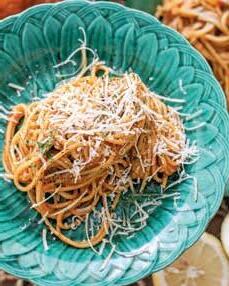
38
From Iran to Italy
Saghar Setaher on the parallels between food cultures
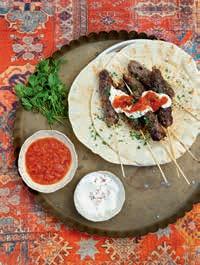

46
A taste of tradition
A commercial interior pays homage to the capital city
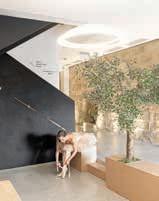

56
Creative cluster
Cultural exchange and cooperation in Valleta

69
Theatre Next Door
New life for an old farm

Satariano marks its 125th anniversary this year. We take a look back at the origins and evolution of one of Malta’s premier brands
In the 19th century, in the beterappointed households, personal hygiene was still assured by bedroom washstands and hidden chamber pots that had to be spirited away discreetly by hapless household servants. Their use persisted into the 20th century, but they were being steadily replaced by a more modern arrangement – a private walled-in space enclosing a flushing water closet, bathtub, and hand basin supplied with running water.
It was in this shifing context that Maltese entrepreneur Roger Satariano first began to import and sell sanitary ware and other building materials in 1898, trading as regional sales manager with Walter W Davies, founder of the eponymous manufacturing and exporting firm based in Birmingham. Roger’s son, George, also started up his own import company trading in the same field. When Walter Davies passed away, father and son merged their respective businesses to form Roger Satariano & Son, a firm that operated as a trade partnership until it eventually became a limited liability company in 1972.


Before long, father and son merged firms to become Satariano & Son, seting up shop in the capital city of Valleta. A bathroom showroom seems an unlikely fit with contemporary Valleta that’s bursting at the seams with trendy restaurants, noisy bars, and café’s spilling out onto every pedestrian area, but at the time, Malta’s capital was the centre of commercial trading activity, with handy access to the port, institutions, and offices.
The Satariano duo quickly built a reputation for themselves as the premier provider of high-quality bathroom fixtures, and by 1934 George Satariano had brokered an exclusivity deal with Ideal Standard, paving the way for expansion and diversification.
As the firm evolved, the brand shifted its focus from commission agents and wholesalers to direct retailers, acquiring their first showroom adjacent to their office in Valletta. With the brand’s growing popularity Roger Satariano & Son expanded their catalogue of bathroom fixtures & fitings to include tiles and building materials, moving to a bigger showroom in Floriana in 1957.
When a housing and hotel construction boom began to take shape in the early 1960s, the firm was

in a favourable position operating out of two prominent locations and a reputation for excellence in the Maltese market, their services were sought afer by high-end clients and businesses across the island. Over the next six decades, Roger Satariano & Son Ltd would work on almost every major construction project on the Maltese Islands and establish longstanding relationships with several international suppliers.
On the 8th of September 1964, George Satariano passed away, and his five children James, Anna, David, Ray and Joe successfully kept the business going, with son James Satariano taking the helm as Chairman and Managing Director.
With their eye on the future, Roger Satariano and Son acquired large
premises in Guardamangia to serve as their new warehouse facility in 1973, where they continued to expand their range of services and products. In 1980, the company moved to a larger, more modern showroom in Valley Road, Birkirkara.


Along the way, the firm expanded into other related sectors serving the



building industry, adding to trading portfolio systems for air-conditioning, solar heating and plumbing pipes and fitings as well as ceramic tiles for walls and floors – not the glamorous part of architecture and interior design, perhaps, but certainly the essentials that make any building liveable. Innovation included the 1985 launch of Hepworth Plumbing products, a push-fit system that revolutionised traditional plumbing installation. Through the years, over 18 million Hep2O fittings and more than 20 million metres of piping have been installed in commercial premises and households across the Maltese islands.
Still operating from Valley Road, Satariano’s state of the art showroom now spreads over 3,000 square metres, possibly one of the largest bathroom, kitchen, and furniture showrooms on the island. From the latest luxury home furnishings to state-of-the-art bathroom solutions, Satariano offers a comprehensive range of products and services and works closely with clients to create bespoke solutions that meet their individual needs and preferences.
As it celebrates its 125th anniversary, Satariano is a long way from the nineteenth century and its small office in Valletta, but it remains a family run business that is now into its fourth generation reinforced by an infusion and new mindset of family members Natasha Chapelle Paleologo and Patrick Satariano together with the experience of Managing Director Joe Satariano. What does the future hold? “We’re looking towards the future with optimism and excitement,” Joe Satariano says. “The calibre and commitment of the youngest generation will ensure the company remains at the forefront of the luxury home solutions market in Malta, and its continuing legacy of excellence and innovation for years to come.” Quality, it seems, will never go out of style.

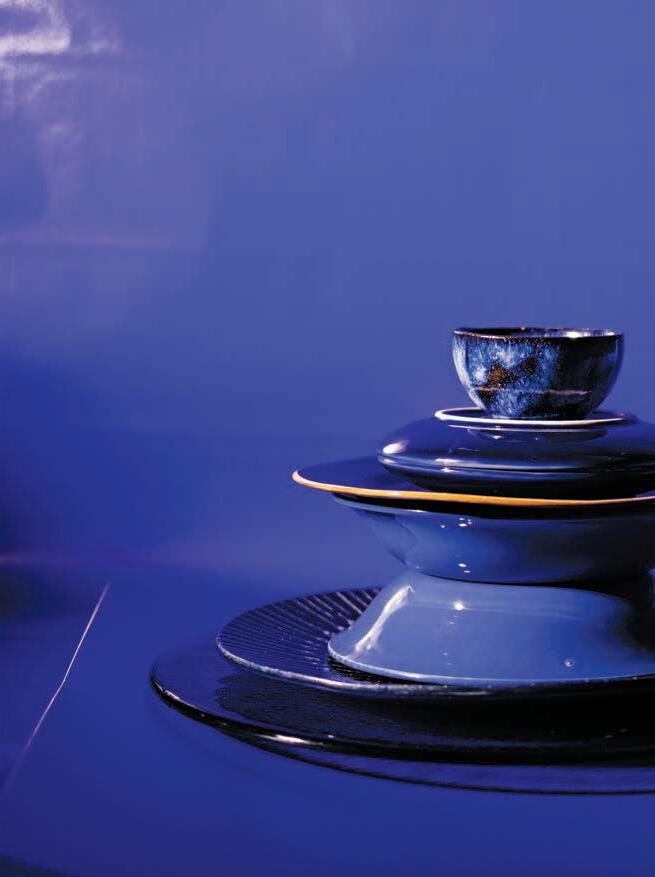
A recent personal health drive at home had me trying to cook for the whole family in a more mindful manner. Trying to please three young men while cuting down on pasta, meats, and sugar is no mean feat. I wanted to show them that making vegetables and pulses the main star of any meal does not necessarily lead to bland eating. I want to use cauliflower to demonstrate that, with a bit of thought, any recipe can be fun and super tasty.

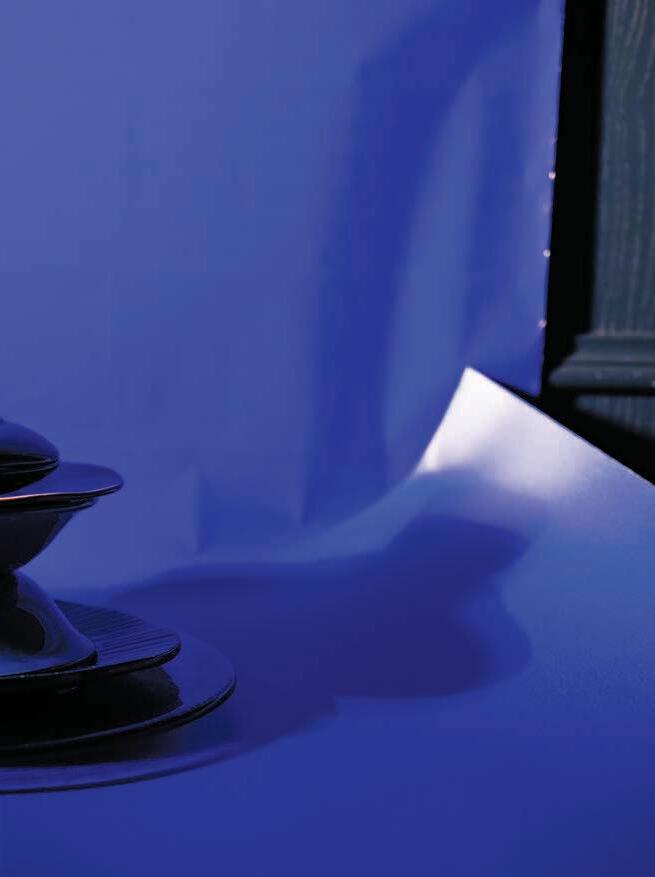

Makes 8
YOU WILL NEED:
450g plain flour
1 teaspoon baking powder
½ teaspoon salt • 2 teaspoon sugar
150ml milk • 30ml vegetable oil
150g yoghurt • 1 egg
1. Sif the flour, baking powder and salt into the bowl of your mixer, and add the sugar. Atach the dough hook, and turn the machine on low.
2. Add the milk, the vegetable oil, the yoghurt, and the egg. Knead the mixture for 10 minutes, then wrap the dough in plastic and let it rest for 1 hour.
3. Divide the dough into 8 pieces and use a rolling pin to roll it out on a floured surface.
4. Cook the flat breads in a nonstick pan or on a flat grill till puffed and golden brown.
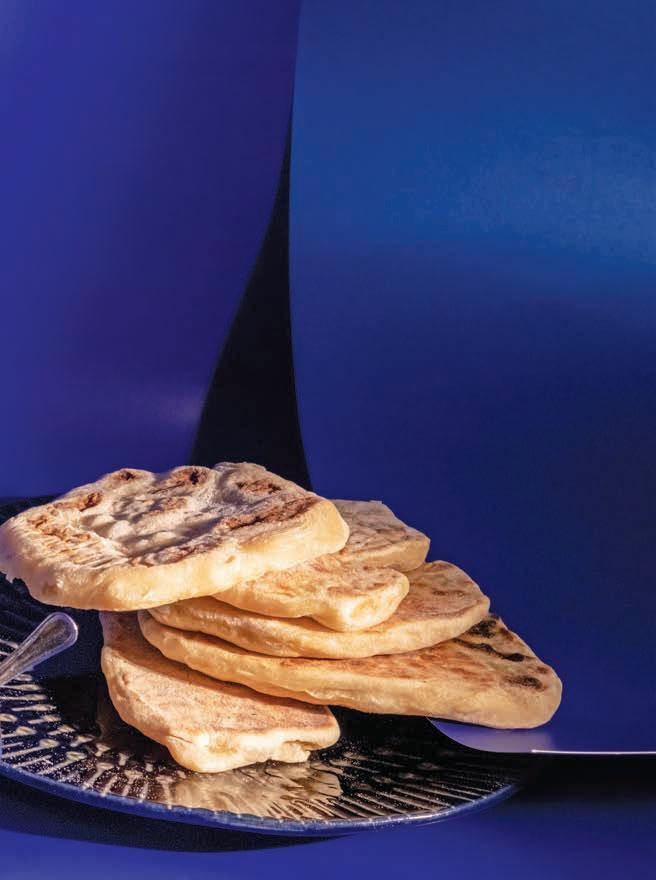
A fragrant Egyptian spice and nut mix, this is usually served with olive oil and bread before a meal. It is great sprinkled on dips, soups, etc.
YOU WILL NEED:
50g hazelnuts
1 tablespoon cumin seeds
1 tablespoon fennel seeds
1 tablespoon coriander seeds
2 tablespoons sesame seeds salt
1. Heat the oven to 180°C. Spread out the ingredients on a baking sheet and roast them for 8 minutes till toasted.
2. Run the mixed ingredients through a food processor to chop them roughly.
3. Let the mixture cool down completely before storing it in a clean jar.
This is deliciously tasty, especially if served warm. Serve it with a bowl of dukkah and flat breads. I like to serve this warm ,so I heat it up in an oven for about 15 minutes before bringing it to table.
Serves 8 as an appetiser
Preparation and cooking 40 minutes
Recommended wine: Bordeaux Blanc
YOU WILL NEED:
500g cauliflower florets
3 cloves garlic peeled chili salt and pepper
1 tin (400g) cannellini beans, drained and rinsed
3 tablespoons light tahini
3 tablespoons thick Greek yoghurt
1. Boil the cauliflower in salted water for a few minutes till just tender, then drain it and cool it in water.
2. Transfer the cooled cauliflower to a food processor and add the rest of the ingredients. Blitz them to a fine paste and transfer it to an oven-proof dish. Cover with foil.
3. Before serving, warm the dish in pre-heated oven for 15 minutes.
This was a sure winner with the young members of our household. Warm spices, fragrant lemongrass, and noodles - what is there not to like?
Serves 6 as a main course
Preparation and cooking: 60 minutes
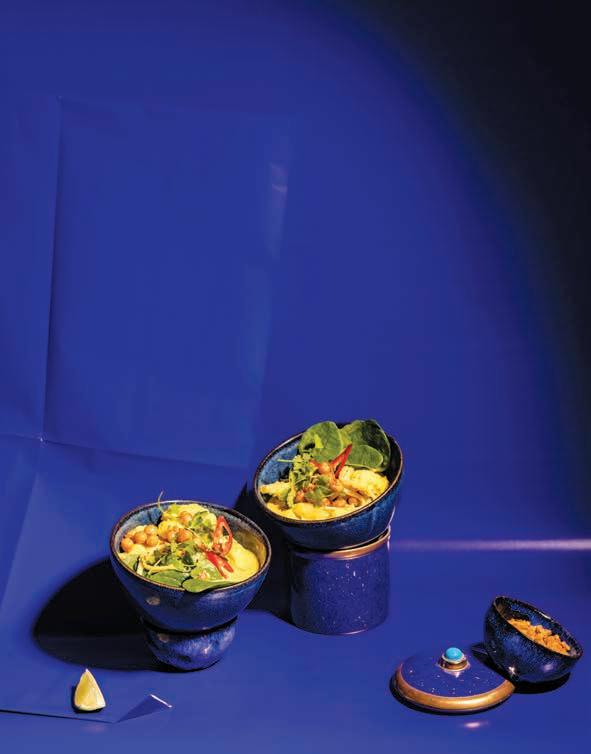
Recommended wine: Pinot Gris
FOR THE PASTE:
1 shallot • 25g ginger • 2 cloves garlic, peeled • 1 chili
1 lime, zest and juice • 20g fresh coriander leaves
1 teaspoon cumin seeds • 1 teaspoon powdered turmeric
2 tablespoon fish sauce • 1 tablespoon sesame oil
FOR THE SOUP:
1 medium cauliflower, separated into florets
1 stalk lemon grass • 400g coconut milk
300ml vegetable stock • salt • 200g noodles
80g fresh baby spinach • 40g salted peanuts
fresh coriander • sliced chilli
1. First, make the paste. Put all the ingredients into a food processor and blitz for a few minutes till a rough paste forms.
2. Heat a pot on the stove and add the paste. Stir fry this for a few minutes. Use the back of a knife to beat the lemon grass then chop it into chunks. Add this to the paste.
3. Mix in the coconut milk. Add the cauliflower and stock and season with salt. Cover the pot, then let it simmer gently for 30 minutes.
4. Meanwhile cook the noodles in salted water till done and drain them. Divide the noodles into 6 bowls and pour over the very hot laksa.
5. Garnish with the baby spinach, salted peanuts, fresh coriander and sliced chilli. I even used some deep-fried chick peas to add a litle texture.

When I prepared this at home for lunch
I cannot say it was met with much enthusiasm by the boys. Their tune changed afer tasting it, and I was lef with an empty serving dish very quickly.
Serves 6
Preparation and cooking 90 minutes
Recommended wine: A white oaked Rioja blend or even Rhone style white such as Chateauneuf du Pape Blanc
YOU WILL NEED
1 tablespoon powdered coriander
1 tablespoon powdered cumin
1 teaspoon chilli powder or flakes
½ teaspoon ginger powder
1 teaspoon smoked paprika
200g thick yoghurt
zest and juice of 1 lemon salt and pepper
1 large cauliflower, tender leaves still attached
1 large onion, peeled and sliced
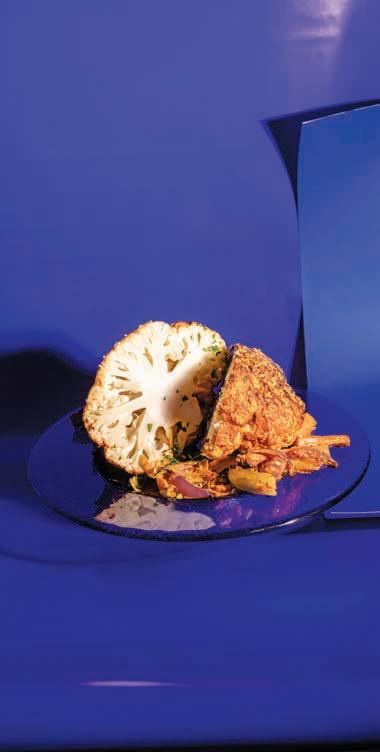
2 cloves garlic, peeled and sliced
2 large carrots, peeled and cut into batons
3 tablespoons vegetable oil water

1. Preheat the oven to 185°C.
2. Mix together the coriander, cumin, chilli, ginger, and smoked paprika. Add the yoghurt to the spice mix and stir well before adding the zest and juice of the lemon. Season with salt and pepper.
3. Remove the leaves from the cauliflower but keep the tender ones. Wash the cauliflower well and drain it.
4. Place the sliced onion, garlic, and carrots into a deep sided baking dish that fits the cauliflower snugly. Place the cauliflower on the vegetables then coat it all over with the spice and yoghurt mix. Drizzle the oil all over then add some water to the base of the dish.
5. Cover the dish with baking paper then seal it with foil. Bake it for 30 minutes, then remove it from the oven and uncover it.
6. Add the tender leaves and coat them with the pan juices before returning the dish to the oven for another 30 minutes to finish cooking and colour all over. Serve hot.
I made cauliflower couscous for the first time to accompany a lamb dish. I flavoured the “couscous” with the meat juices and it took the boys a few mouthfuls to realise it was not the real deal. Today, I’ve paired it with a stew of cutle fish cooked in its own ink.
Serves 4
Prep and cooking: 120 minutes
Recommended wine: A dry and crisp Riesling
YOU WILL NEED:
1 whole medium cauliflower salt and pepper
2 tablespoons extravirgin olive oil
1. To prepare the couscous you need to separate the florets from the stalk. Wash and drain them very well. Then, simply transfer them to a food processor and pulse them a few times till you end up with what look like grains of couscous.

2. Transfer the cauliflower to a bowl, season with a litle salt and pepper, drizzle with the extra-virgin olive oil, and mix well.
3. To cook, place the cauliflower into a sifer which has a fine mesh and cover it tightly with cling film. Pierce the cling film a few times with a pointed knife then steam the cauliflower over boiling water for about 8 minutes.
4. Serve at once.
YOU WILL NEED:
1kg cuttlefish
4 tablespoons extravirgin olive oil
1 onion, peeled and finely chopped
4 cloves garlic, peeled and finely chopped chilli
1 glass dry white wine
1 tin polpa di Pomodoro salt and pepper
1. Ask your fishmonger to clean the cutlefish, retaining the allimportant ink sacs.
2. When you get home, cut the fish into 3cm pieces.
3. Heat the extra-virgin olive oil in a pot and add the onion and garlic. Stir fry for a few minutes to sofen but don’t allow them to colour.
4. Add chilli, if using, then add the cutlefish. Cook on high heat, stirring ofen, for 5 minutes then douse the mixture with the white wine and continue cooking to reduce the liquid.
5. Add the tomato pulp. Fill the tin with water and rinse it out into the cooking pot. Season with salt and pepper.
6. Bring the pot to the boil, then lower the heat and let the pot simmer away for 45 minutes or till the fish is tender.
7. Now, add the ink sacs, mixing them in quickly. I like to pierce them before adding them to the pot. Let the pot simmer for another 10 minutes, until the sauce is ready to serve.
This is silky-textured and very delicate in flavour.
Serves 8
Preparation and cooking 90 minutes
Recommended wine: Chablis or any similar unoaked Chardonnay
YOU WILL NEED:
50g butter
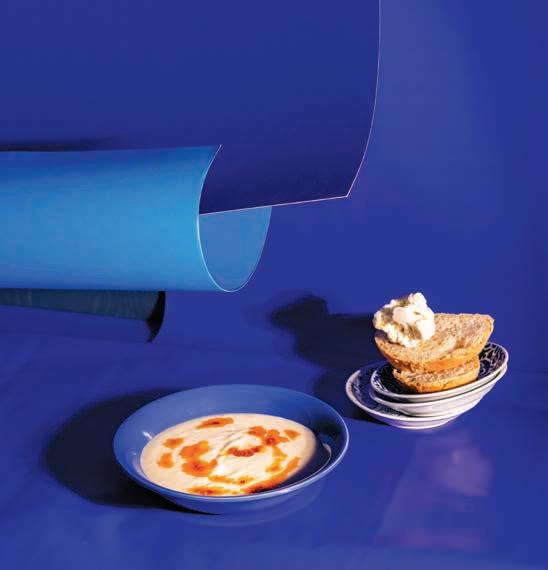
1 fennel bulb, cleaned and chopped
600g cauliflower florets
1 granny smith apple, peeled and chopped
300g potato, peeled and chopped
roughly 1 litre water
500ml milk
salt
ground white pepper
TO GARNISH
chili oil
1. Melt the buter in a large pot. Add the fennel and stir fry on moderate heat for about 5 minutes to sofen.
2. Add the cauliflower and apple and cook for a further 5 minutes, stirring ofen.
3. Add the potato, water and milk and season with salt and pepper. Bring the mixture to the boil, cover the pot, then reduce the heat so that the soup just simmers gently for 40 minutes.
4. Use a stick blender to process the mixture until fine. For an extra fine and silky finish, run the soup through a mouli legume.
5. Serve garnished with a light drizzle of chili oil.


Omiting pasta completely from our diet at home would lead to a mini riot, so as an offset, I try to include vegetables in the sauce whenever I can. Cauliflower is the star here, elevated by the addition of saffron.
Serves 6 as a starter
Preparation and cooking: 40 minutes
Recommended wine: A dry, refreshing Gavi would work well. This is also the perfect opportunity to enjoy a crisp Provence-style rosé.
YOU WILL NEED:
70g raisins
2 good pinches good quality saffron strands
4 tablespoons extra-virgin olive oil
1 red onion, peeled and thinly sliced
2 cloves garlic, peeled and sliced (add more if garlic is your thing)
8 anchovy fillets
chilli
500g cauliflower florets, washed and drained
salt and pepper
50g toasted pine nuts
a few mint leaves
1 handful parsley, finely chopped
500g bucatini
fried breadcrumbs, to serve
1. Place the raisins into a small bowl and cover them with warm water. Place the saffron into another small bowl and soak it with tepid water. If using good quality fine saffron, a good 2 pinches works wonders.
2. Heat the extra-virgin olive oil in a large frying pan that has a lid. Add the sliced onion and garlic and stir fry them till sof. Add the anchovies and chilli and cook for a couple of minutes before adding the cauliflower.

3. Add the saffron, together with its soaking water. Season with salt and pepper. Cover the pot and let it cook for 5 minutes. Drain the raisins and set them aside till needed. Meanwhile, cook the pasta in plenty of salted boiling water. Drain it when it is still quite al dente and keep the cooking water.
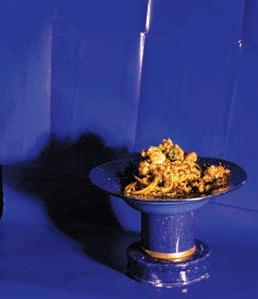
4. Transfer the pasta to the frying pan together with the cauliflower and carefully toss it. Add a litle of the pasta water to keep everything moist.
5. Add the drained raisins, pine nuts, and herbs. Toss the mixture for a few seconds before serving topped with fried breadcrumbs.
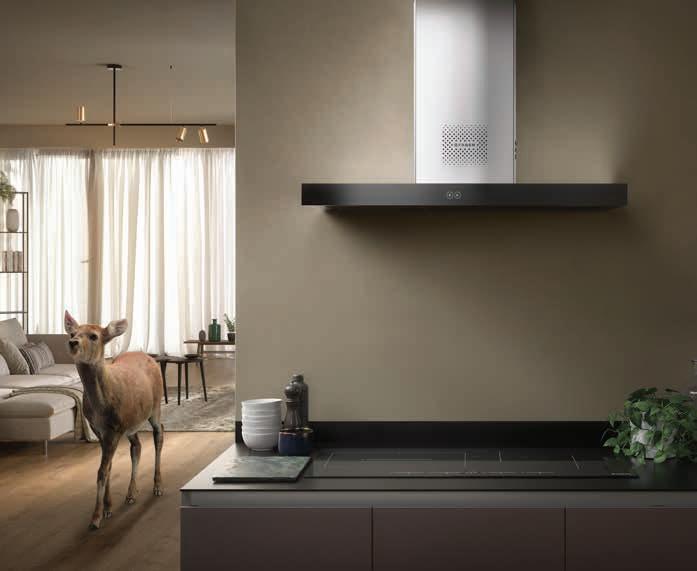

En Primeur week in Bordeaux this April drew some 6000 wine specialists from around the world. The Bordeaux en primeur system gives customers the opportunity to buy these wines in just a couple of weeks, well before they are botled. While there, I tasted well over 250 wines from the 2022 vintage straight from the barrel. The wines will continue to age in the barrel for the next two years, before being botled and released.
It is part of my job to determine the wines’ potential before advising clients on the best ones to buy from this vintage. So, while I was in Bordeaux, I had appointments on both the left and right banks of the Médoc river, visiting some of the largest and smallest Châteaux in the region where the quality of the wine is not always directly proportional to Château’s size. My agenda, carefully planned to the minute by my négociant (wine trader) months in advance, was so full I knew I had to be in the best physical shape and my palate fresh enough for a tasting marathon over my week there.


There’s a certain excitement that only Bordeaux manages to create and there was already a lot of hype around the 2022 vintage, so I was excited to finally get to taste it and test the hypothetical opinions that were based on the extreme weather. Afer a rather wet 2021, 2022 produced record-breaking heat and drought throughout the region, creating extremely difficult conditions for the vignerons who had to contend with a combination of heatwaves and an unprecedented lack of rain.
At nine o’clock on my first morning I was ready for my first tasting at the extraordinary Château Mouton Rothschild. Armed with a small notebook, I was poured the first wine which was the Pastourelle de Clerc Milon, the second wine of Château Clerc Milon. I was taken aback by its sheer freshness and power. The wine was approachable, if not ready to drink. “If this is a preview of what to expect of the vintage,” I thought to myself, “I’m going to be in for a good time.”
I made my way down around the room tasting the Château Clerc Milon , Château D’Armailhac , Château Petit Mouton Rothschild and the Grand Vin from Château Mouton Rothschild and I was impressed. It was early in the day and the Rothschilds don’t ofen get it wrong, but these wines had power, finesse, and a tension I loved. As the day progressed, I had already made up my mind that the vintage was definitely great, but I do not have the gall and experience to declare it the vintage of the century. I’ll leave that up to the professional wine-critics.
However, I would dare to compare the best wines to a prima ballerina with amazing grace, beauty, ethereal elegance and sheer power. I felt there was a commonality of refreshing, mouth-watering salinity similar to freshly shucked oysters on warm day by the sea in Arcachon – a freshness that was totally unexpected throughout the wine-world.
Due to the extreme heat and drought throughout the region, the grape berries were exceptionally small with thick skins and very litle juice which caused the trade to expect rich, heavy wines with some cooked fruit flavors. But these were different. There had been talk that the wines would be similar to the last hot vintage of 2003 but we quickly realized this was not the case. Other comparisons were made with legendary vintages of 1945, 1947, 1961, and 1982 but when I asked Annabelle Grellier, export director of Château Palmer, she couldn’t compare 2022 fully to any previous vintage she remembers and believes she can only compare it to having the power of 2018 and the balance of 2019 – two Bordeaux vintages that are outstanding in their own right.
Due to the rising temperatures and extreme weather conditions over the past decade, Bordeaux wine producers have long been discussing the way forward to protect their future. Only recently, six new grapes including the Portuguese Touriga Nacional and Marcelan beter known to withstand heat were approved as part of the Bordeaux blend. Many technical experts even discussed whether Merlot would soon become a grape of the past in Bordeaux,

but 2022 has turned these theories upside down. So much so, I would hasten to add that 2022 could be considered a Merlot vintage, as this grape variety did particularly well despite the weather conditions. The question on everyone lips is how could the hoter summer of 2022 have produced fresher wines than in 2003?
The numbers show that despite the hot days and several heatwaves, the evenings remained consistently cool and gave the vines much needed respite. Still, vintners struggled to explain the incredible freshness. Henri Lurton, owner and winemaker at Château Brane-Cantenac in Margaux, was brutally honest in his reply that, despite his master’s degree in viticulture, he still cannot understand the freshness of the 2022 vintage. Others believe that, since 2021 was a particularly wet year, there was enough water for the vines to reach deep down into their reserves, especially in clay soils, keeping themselves hydrated. If we had goten the 2022 vintage afer the warm and dry 2020 vintage, the result would have probably been very different.
The technical director at Château Cos D’Estournel believes that the slow development of heat stress early on gave the vines more time to adapt and build a natural resistance. Other wineries, such as Château Cheval Blanc, explained the freshness as a consequence of the rain shower they got late in June, believing this was instrumental to their wines’ success.
While the vintage success was indeed head-scratching, several trends such as an early and long harvest and specific canopy management emerged. Pierre Olivier Clouet, technical director of Château Cheval Blanc, felt the grapes reached peak maturity as early as August, and so they could be harvested at the earliest time ever in the history of the Château. Radical biodynamic producers such as Château Pontet Canet instilled techniques including a special “sunscreen” to cover the grapes, according to Justine Tesseron, fourth generation owner of the Château. Other techniques such as specific canopy-management
and cover-crop were ofen mentioned as key to keeping the berries cool.
What is evident is that vintners’ decisions were indeed conducive to the success of the 2022 vintage, though not every producer succeeded. Some wines are over extracted and excessively tannic, such that renowned international wine critic Jane Anson doesn’t suggest purchasing Bordeaux blindly even though there are so many great wines in this vintage. She believes that wineries with a presence in warmer new world countries such as California or Australia could have an edge due to their experience of dealing with hot, dry summers in other parts of the world. She specifically mentioned Château Durfort-Vivens crafed by Gonzague Lurton, who also has a winery called Acaibo in California’s Napa Valley and who has produced an elegant and beautifully constructed wine as is the Grand Vin from Château Smith Haut Lafite, who have also recently bought a winery in Napa Valley.
I know that the 2022 vintage was remarkable because, despite being the hotest vintage on record, vignerons in Bordeaux have managed to produce superb wines. Many agree that the vintage is surprising, unexpected, and unique in the most positive of ways. Is the 2022 vintage evidence that Bordeaux will cope with climate change? Time will tell.


While putting all my notes together, obsessively brushing my purple-tinged teeth, and mulling over my favorite wines of the 2022 Bordeaux vintage, I am convinced it includes wines for every palate. Many of the beter ones will be approachable and ready to drink early on but are also capable of aging over the next 40 years or so. There are also some that will not blossom before they are at least 15 years of age. All said, I have no doubt that the 2022 vintage will be mentioned for decades, and I shall be adding several botles of it to my wine cellar.

Cooking with produce that is in season and grown locally is the mentality we embrace at home. May is a something of a shoulder month but field-grown aubergines are ready for harvesting and enjoy a long season. They’re not my favourite ingredient but they’re so versatile and I enjoyed the challenge of coming up with different ways of preparing them. In most of the recipes here, I use roasted aubergine. Prepare them by first washing and drying them. Then, leaving the stalk and skin on, roast them at 180°C for about an hour. Some cooks like to prick the skin first, but I don’t and the aubergines still roast beautifully.
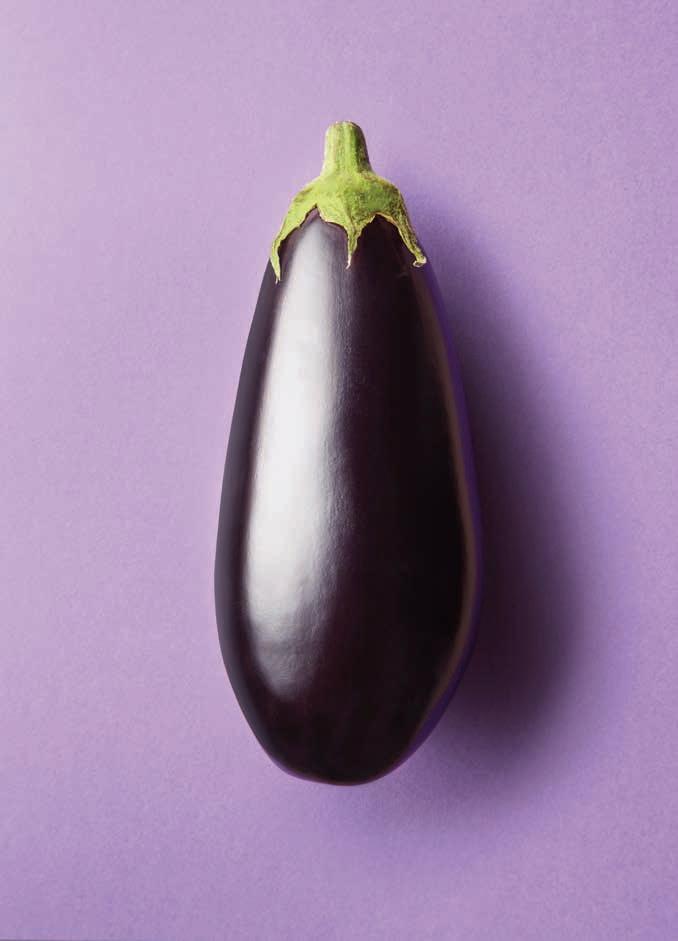


This can be prepared ahead and served with homemade carta di musica, or other crackers and crudités.
YOU WILL NEED:
1 large can of chick peas, drained and rinsed
1 roasted aubergine, pulp only

1 tablespoon tahini
1 tablespoon Greek yoghurt juice of half a lemon
½ teaspoon lemon zest
1 small clove of garlic
a sprinkle of ground cumin
6 tablespoon extra-virgin olive oil
1 tablespoon finely chopped parsley, plus more to garnish salt and pepper, to taste
1. Place all the ingredients into a large bowl and use a hand blender to blend everything to a smooth paste. Season to taste.
2. Store in the fridge until needed. Before serving, drizzle with olive oil and garnish with a sprinkle of parsley.
Carta di musica is a traditional Sardinian flat cracker “bread”, named afer sheet music. It should be baked until crisp and thoroughly dry and, when cool, it will remain fresh for days afer baking if stored in an airtight container.
YOU WILL NEED:
200g bread flour
4g dry active yeast
4g caraway seeds
15g golden flax seeds
25g extra virgin olive oil
225g lukewarm water
1. Mix all the ingredients together and stir them with a hand whisk until smooth. Cover the bowl well and let the mixture rest for an hour.
2. Preheat the oven to 185°C and line a baking tray with non-stick paper.
3. Afer resting, the mixture should resemble a bubbly, thick pancake bater. Use a spatula or palete knife to spread this very thinly over the baking paper. Let it bake in the preheated oven for about 25-30 minutes, or until it is golden all over.
4. Remove the baking tray from the oven and lif up the coated baking paper to transfer the carta di musica to a wire rack to cool down.
5. Before serving, break it randomly into large pieces. Or pop the broken pieces into an airtight container to serve later.

Serve this as a side dish with grilled or barbecued meats or as part of a main course in a vegetarian or vegan meal. They can be enjoyed warm or cold.
YOU WILL NEED:
2 whole aubergines
FOR THE SPICE MARINADE:
4 teaspoons extra virgin olive oil
2 teaspoons water
2 teaspoons ground cumin
1 teaspoon Chinese 5 spice
a tip of a teaspoon ground cardamom
½ teaspoon of white pepper
2 teaspoons brown sugar
TO SERVE: sumac
toasted pine nuts
extra-virgin olive oil
finely chopped parsley
1. Preheat the oven to 190°C.
2. Make the spice marinade by mixing all the ingredients together. Set the bowl aside.
3. Wash the aubergines and place them in a baking tin into the preheated oven. Bake them for 30 minutes, then take out of oven. Don’t turn the oven off yet.
4. Slice the aubergines in half lengthways. Score the flesh and spread the spice mix onto the 4 surfaces.
5. Place the coated aubergine halves back into the oven and bake for a further 20-25 minutes.
6. Remove them from the oven and let them cool slightly, then sprinkle them with sumac, add the toasted pine nuts, drizzle with olive oil and sprinkle with parsley.


These can be enjoyed warm or cold, served in a seeded bun of your choice with a selection of fillings. I used an onion chutney, aged cheese shavings, finely sliced onion, avocado, tomato and salad leaves. Alternatively, shape the uncooked mixture into bite-sized balls and serve them as an appetizer with a herbed mayo.
YOU WILL NEED:
1 large potato, boiled with the skin on
1 large roasted aubergine
10 sundried cherry tomatoes
8 basil leaves
1 medium onion
olive oil
2 fillets of anchovies in oil
1 teaspoon grated lemon zest
a few crushed fennel seeds
a sprinkle of oregano
black pepper
1 egg
2 tablespoons grated Parmiggiano cheese
3 tablespoons breadcrumbs, and more to coat the patties
1. Finely chop the onion and cook it in some olive oil, with the anchovy fillets and fennel seeds until the onion is sof. Set the mixture aside to cool.
2. Prepare a mixing bowl and keep adding the ingredients to it as you prepare them
3. With a fork, roughly mash the potato and place it in a large bowl. Finely chop the roasted aubergine (with the skin on) and add it to the bowl.
4. Rinse the tomatoes, dry them, and chop them finely. You should have about 2 tablespoonfuls. Chop the basil finely.
5. Next, add the cooked onion, egg, cheese, lemon zest, the finely chopped basil, oregano and 3 tablespoons of breadcrumbs to the mixture.
6. Season the mixture and stir it well. Adjust the consistency at this point by adding more dry ingredients or a bit more olive oil. It should be firm enough to shape it into 4 balls using your hands. Roll each ball in breadcrumbs, and use the flat of your hands to press it down into a paty.
7. Cook the pressed paties in a mix of olive oil and sunflower oil, until golden on both sides. Then, drain them on kitchen paper.

Mix this sauce with your favourite cooked pasta and sprinkle it with fresh parsley and a touch of lemon zest before serving. It can be prepared ahead and frozen until needed. The chilli and grated cheese can be served separately.
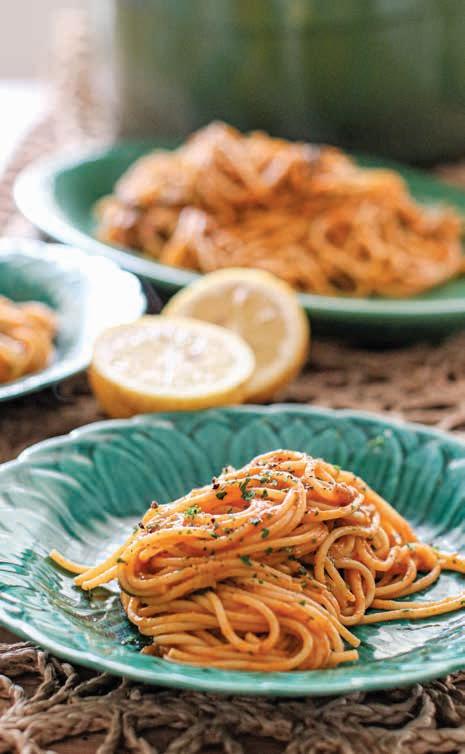
YOU WILL NEED:
1 leek
1 onion
4 anchovy fillets in oil
black pepper
some white wine
1 piece of fresh garlic or a few cloves of dried garlic
4 tablespoons extra virgin olive oil
2 tablespoons tomato paste
1 litre of home-made tomato passata (or use tinned if fresh is not available)
fresh herbs (I used marjoram, mint, and lots of fresh basil) pulp of 1 roasted aubergine (roasted whole in the oven for an hour, then pulp removed)
lemon zest
fresh parsley
chilli (optional)
TO SERVE grated cheese
1. Put the olive oil in a pan set over medium to high heat. Cook the anchovy fillets, onion, and leek until sofened, then add the garlic and fresh herbs and cook for a few more minutes.
2. Add some white wine and cook for another few minutes.
3. Add two tablespoons of tomato paste and the passata. Cover the pan and let it simmer for around 20 minutes.
4. Add the roasted aubergine pulp to the pan, cover the pan again and let it cook on low heat for a further 40-60 minutes.
5. Blend the mixture until smooth or, for a more rustic sauce, half-blend it to a chunky paste.
A medley of freshly harvested spring vegetables and herbs, roasted to perfection. This simple dish can be served as a side with grilled fish or meat, or as a standalone with plenty of warm, crusty bread to mop up the juices.
Serves 6 as a side dish
YOU WILL NEED:
1 large aubergine
2 red peppers
8 fresh onions or two of the usual ones
2 courgettes
30 cherry tomatoes
basil leaves
10 cloves of garlic
some fennel seeds
extra-virgin olive oil

sea salt
fresh rosemary
1. Heat the oven to 185°C
2. Wash, trim or peel and dice the vegetables and arrange them on a baking tray in a shallow layer.
3. Drizzle the vegetables with olive oil, scater the whole garlic cloves on top, and sprinkle with the herbs and fennel seeds. Season with salt and pepper.
4. Roast the vegetables in the preheated oven for 40 minutes to an hour until they turn golden.

5. Bring the tray out of oven and stir the cooked vegetables together mix. Serve these warm or cold.
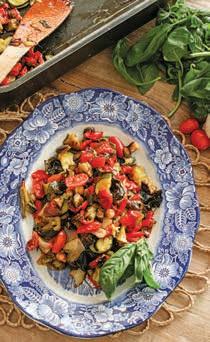

I made small cupcakes, so I weighed out 50g of bater into each cupcake case, but this can also be baked into larger cupcakes or a whole cake.
YOU WILL NEED:
150g flour
100g dark cocoa powder
250 g sugar
2 teaspoons baking powder
125g roasted aubergine pulp
100g sunflower oil
100g milk
2 eggs
TO SERVE: caramel sauce, ready made sea salt
1. Preheat the oven to 170°C.
2. While the oven warms up, prepare the cake bater. Sif the flour, baking powder and cocoa into a large bowl, then mix in the sugar.
3. In another bowl, mix the wet ingredients together and blend them until smooth. Fold the wet mixture into the dry mixture and stir them until well combined.
4. Weigh out 50g of the bater into an individual cupcake case and place it on a baking tray. Repeat with the rest of the cake bater, until it is all used up.
5. Place the baking tray in the preheated oven and bake the cupcakes for 18 minutes. If you’re making larger cupcakes, or a whole, cake, you will need to let them bake for longer.
6. Remove the cupcakes from the oven and transfer them to a wire rack to cool. Serve them topped with caramel sauce and sprinkled with sea salt.

Built-in appliances have come a long way since their inception. Appliances in general have become more versatile, efficient, and aesthetically pleasing. Stand alone units have evolved to built-in appliances which nowadays complete modern kitchens. Such commodities offer homeowners a range of options to choose from.

Nowadays, homeowners continuously look for appliances that are sleek and seamless to complement their choice of kitchen, bathroom, and washroom. Built-in appliances are designed to fit into cabinetry which will blend well with countertops and the surrounding environment.
Having built-in appliances takes up less floor space and allows the kitchen to look less clutered, especially in smaller kitchens or open–plan layouts. This applies not only for homeowners doing up their kitchen, but also for entrepreneurs who have apartments for rent but with limited space.
It is not a mystery that in today’s fast-paced world, comfort and efficiency feature on top of the list of requirements. Smart appliances are becoming more present in our homes, and smart home technology has become the new norm in
households, making life easier. With the use of sensors, smart appliances can monitor, adjust their setings and provide feedback to users. Today, one finds smart washing machines, dryers, ovens, coffee makers and more. These appliances can be controlled remotely through smartphone apps or voice assistants.
Smart ovens also come with assisted cooking features to avoid guesswork when cooking. Some features include automatic temperature set up, time adjustments, and roasting systems that allow for the cooking of completely different dishes simultaneously using all oven levels without any intermingling of flavours. Thanks to the pyrolytic selfcleaning system, oven cleaning time has been dramatically reduced as the oven reduces grease and food residue, turning it into ash.
Last but not least, some smart appliances have also become more energy-efficient, resulting in both environmental benefits and cost savings.
Stand-alone appliances such as the American Style, French Door, XXL refrigerator and side-by-side refrigerators can be aesthetically pleasing and can be moved around and placed wherever there is space which can be beneficial for those individuals who like rearranging their kitchen layout. Property owners who rent out their property might opt for stand-alone appliances due to their flexibility to conduct any modifications that might be required from time to time.
On the other hand, built-in appliances are designed to be installed directly into kitchen cabinetry and blend well with the customers’ exigencies.


For the early innovators, the built-in Fridge Freezer has a new width of 75cm as opposed to the traditional 60cm one. Apart from accommodating modern kitchen designs, this XXL built-in appliance has a super cooling function which

allows food placed inside to cool faster, while still protecting already cooled food. Sensors constantly monitor and control the ambient of the fridge-freezer temperature while the modern individual who is always on the go can monitor the appliance through a smart phone or tablet.
When it comes to installation and after sales service, Oxford House is committed to continuously strive to exceed customers’ expectations and provide them with a fast, exceptional service, while offering support throughout their ownership experience. Furthermore, Oxford House offers a 5-year warranty on all Bosch and Neff appliances for further peace of mind. For more information about this new Bosch 75cms built-in fridge freezer and the Oxford House Spring Sale throughout the month of May, one can visit www.oxfordhouse.com.mt, or visit the Facebook page.

When Iranian writer and food photographer Saghar Setareh first moved to Italy at the age of 22 to study at Rome’s Fine Art Academy, she was enchanted by the rich food culture of her adopted country. This inspired a curiosity in the cuisine of her homeland and the surrounding countries of the Levant and Eastern Mediterranean. In her own culinary journey from Iran to Italy, she describes the many parallels that link Middle Eastern and Mediterranean food cultures, and shows how ingredients and recipes - unconstrained by borders - are shared and transformed through the immigrant experience.

Food, article, and photography: Saghar Setareh
All recipes are from Pomegranates & Artichokes: Recipes and memories of a journey from Iran to Italy by Saghar Setareh (Murdoch Books, £26).
Photography by Saghar Setareh.


The simple ratio for this recipe is 4 eggs, 4 tablespoons sugar and 400g mascarpone.
Serves 6–8
YOU WILL NEED:
4 eggs, separated
4 tablespoons sugar (see note)
zest of 1 lemon
400g mascarpone
16 savoiardi (ladyfinger biscuits), approximately
FOR THE STRAWBERRIES:
500g strawberries
juice of 1 lemon
3 tablespoons sweet Marsala
3 tablespoons sugar
1. Hull the strawberries, then cut them into quarters and place them in a bowl. Dress with the lemon juice, Marsala and sugar. Cover and leave to macerate for at least 2 hours — or beter still, overnight in the fridge — until the strawberries are siting in a pool of sweet, slightly tangy crimson liquid. Strain the strawberry liquid into a deep dish large enough to roll the biscuits in, and set the strawberries aside.
2. Whisk the egg yolks with the sugar and lemon zest using an electric mixer until pale and fluffy. No sugar grains should be felt if you rub the creamy mixture between your fingers. Gently mix in the mascarpone until smooth.
3. Using a clean whisk and a very clean bowl, whip the egg whites until white and stiff; adding a tablespoon of something acidic like lemon juice helps. In a circular movement, very delicately fold the egg whites into the mascarpone cream.
4. Set out six to eight nice-looking cups, or fancy litle glasses. Add a dollop of the mascarpone cream into the botom of each cup, then spoon in some strawberries. Roll a biscuit a few times in the strawberry juice and let it suck in the liquid at its leisure (unlike the method used with the coffee in the classic tiramisu). Break the biscuit into pieces so that it fits in the cup, pushing down a bit to fill any gaps. Add more strawberries, then a good dollop of mascarpone cream, and repeat. Before finishing with one last layer of mascarpone cream, gently tap each cup on your work surface to setle the ingredients, so that empty spaces are not lef in the middle.
5. Cover each cup loosely with foil and chill in the fridge for about 4 hours before serving, so that the mascarpone cream sets. They are then best served straight away.
The Iranian adoration of yoghurt is a love story going back to ancient times, with yoghurt appearing as “Persian milk” in Al-Baghdadi’s celebrated thirteenth-century cookery book, Kitab al-tabikh (“The Book of Dishes”). Yoghurt is ever-present on the Iranian table, mostly just in plain form as something to spoon alongside literally everything, but especially rice, and in particular mixed polows such as lubia polow.
Vegetables — even raw, but often cooked — when drowned in yoghurt are called borani in Iran. Indeed, in A Safavid Period Cookbook, documenting the food of the Persian court in the 1600s, it says “all types of qalie (stews/ khoresh) to which yoghurt and garlic is added are borani”. This could indicate that boranis used to have meat in them, too — or that multiple varieties of meat were added to the kings’ borani merely to please the royal palate.
I have been told that in Isfahan, the historical and cultural heart of Iran — sometimes known as the “Florence of the Orient”, and incidentally also the capital of the Safavid dynasty — the ultimate show-off at a wedding would be to serve the yoghurt stew, khoresh-e māst. Served cold or at room temperature, khoresh-e māst is a stretchy “cream” made of shredded and pounded lamb, mixed with thick strained yoghurt, sugar and so much saffron to make the plate shine like a glorious sunset on the table. Garnished with almond slivers and barberries, this dish could well be a souvenir of the meaty boranis of the Safavid Empire.
However, the late scholar and literary translator Najaf Daryabandari says in The Rt. Honorable Cookbook: From Soup to Nuts that borani is in fact a form of salad, where instead of ‘drizzling’ the dressing over the ingredients, we submerge them in the sauce (yoghurt).
In Sofre-ye Atma’eh, a cookbook from the 1800s Iranian court, the king’s cook mentions seven types of borani, none of which has meat in them: spinach (and other greens such as chard), marrow, beetroot, aubergine, green bean, cardoon and mushroom. Basically any vegetable, fried, grilled or charred (like the aubergine in mirza ghasemi), drowned in yoghurt, perhaps with grated garlic, would make a delicious borani.
Iranian yoghurt is usually thick. In mid-spring, amazing sheep yoghurt appears, but yoghurt is mostly just made from cow’s milk these days. For most dips, it’s advisable to use strained yoghurt — mast chekideh in Persian and labneh in Arabic (see recipe below; omit the jam). I also find that a good full-fat yoghurt works well — and that organic yoghurts do taste beter.

Please don’t confuse this with tzatziki, the famous Turkish/Greek yoghurt and cucumber dip.

Although it is undoubtedly very similar, the Iranian version is sofer in flavour, mainly due to the lack of garlic. The simplest Iranian mast-o khiar contains only finely diced cucumber and a pinch of salt, and perhaps a garnish of dried mint. This is a slightly fancier one with walnuts and raisins, which I adore, but feel free to omit these. Serve as a fabulous side dish for grilled meats; I also enjoy it for lunch on a hot summer day.
YOU WILL NEED:
2 cucumbers, or 4 Persian/ Lebanese cucumbers, about 250g 20g walnuts, coarsely chopped • 30g raisins
1½ teaspoons dried mint, or a handful of fresh mint leaves, finely chopped
½ teaspoons salt • 400g plain Greek-style yoghurt Damascus rose petals, to garnish
1. Peel the cucumbers and dice into 5mm pieces. Combine in a bowl with the walnuts, raisins, mint and salt.
2. Fold the yoghurt through and mix well. Serve cold, with rose petals scatered on top.
Another classic borani, but with a wonderfully different flavour palete. I like this one on the sweet side (hence the sugar), but not everyone does. If your beetroot has the stems and leaves intact, you can cook these, chop them up and mix them through the dip as well. I like to keep in some chunky bits of beetroot, as they feel beter in the mouth when you chew on them. Throw in a handful of coarsely chopped walnuts as well if you feel fancy.
Makes about 3 cups
YOU WILL NEED:
300g beetroot (beets), cooked and peeled
400g plain Greek-style yoghurt, strained
½ teaspoon salt
1 tablespoon sugar, or to taste
Dice the beetroot, some finely, some coarsely, and combine in a bowl with the yoghurt, salt and sugar. Rest at least for 10 minutes in the fridge before serving.
In this classic borani, you can replace the spinach with any leafy greens, such as chicory, chard, kale and wild leeks. Saffron and golden onion are crucial to a borani made with greens, whereas in boranis made with vegetables such as aubergine, green beans or marrow, I’d replace these with grated raw garlic. Use a pestle and mortar to grind the saffron with a pinch of sugar. Brew it for 10 minutes in three tablespoons of hot water that is off the boil. Use a glass teacup and keep it covered.
Makes about 3 cups
YOU WILL NEED:
150g cooked English spinach (see note below)
400g plain Greek-style yoghurt • ¼ teaspoon salt
1½ teaspoons golden onion
¼ teaspoon freshly ground black pepper
½ teaspoon saffron infusion to garnish (optional)*
Combine the spinach very well with the yoghurt, trying to break the spinach apart with a spoon. Mix with the onion, salt, and pepper. Serve in a bowl, drizzled with the saffron infusion, if desired.
Note: To yield this amount of cooked spinach, start with about 250g frozen spinach, or 500g fresh spinach.
All the senses are engaged when visiting the cities of the Levant and the eastern Mediterranean, with the stunning natural scenery and historical landmarks, the sound of church bells and the call to prayer from the mosques, the shouts of street vendors, the horns of cars and the melodies of the lute-like oud. Before we get to taste the remarkably delicious food, there comes the smell — and the smell of this land for me is that of faty meat grilling on charcoals: the smell of kebabs.
I’m not a phenomenal griller myself at all, but here’s a recipe for simple, tiny kebab skewers that can be made at home on a grill pan, or on a barbecue if you’re lucky enough to have access to one.
Instead of minced (ground) lamb (which is my preference here), you can use any minced red meat, as long as there’s a good percentage of fat. Indeed, in Istanbul and western Turkey, where lamb is expensive and harder to find than in eastern Turkey, many kebab places use mostly beef with only some lamb tail fat to add that gamey, greasy flavour. Naturally, I don’t recommend this.
Kebab giaourtlou is a common dish in Greece, although it’s originally from Turkey, where it’s called yoğurtlu kebap. It means “kebab with yoghurt” — not to be confused with iskandar kebab, which is similar, but has yoghurt on the side, with the meat served on a bed of chunky bread pieces dressed in buter and a pool of tomato sauce. These litle skewers are served on a whole pita bread (and topped with another one, to keep them warm), and the tomato sauce and yoghurt are served on top, or on the side as a dressing to add to each mouthful of meat wrapped in bread.
As with all kebabs and meatballs with minced meat, remember that you need to knead the meat with the spices and let it rest, so that it won’t fall off your skewers.
If you have wooden skewers, make sure you soak them in water for at least an hour before using them, so they don’t burn.
You can prepare the kebabs a few hours before grilling and keep them in the fridge on a plate, separating them with baking paper if necessary to ensure they’re not sticking to each other. Give them an extra squeeze just before grilling to make sure the meat is sticking to the skewers.
FOR THE KEBABS:
50 g minced (ground) lamb
1 small onion, or ½ large one, grated
1 handful of chopped parsley
1 garlic clove, grated
1 tablespoon olive oil
1 tablespoon dried breadcrumbs 1½ teaspoons tomato paste (concentrated purée)
1½ teaspoons salt
½ teaspoon freshly ground black pepper
1 teaspoon sweet paprika
1 teaspoon ground cinnamon
½ teaspoon ground cumin
½ teaspoon dried oregano
FOR THE TOMATO SAUCE:
2 tablespoons olive oil
1 small onion, or ½ large one, diced 400g tin diced tomatoes, or 3–4 fresh large tomatoes, diced
1 teaspoon sugar
½ teaspoon salt
½ teaspoon smoked, hot or sweet paprika
FOR SERVING:
2 tablespoons olive oil, for grilling
3–4 large flat breads 300g plain Greek-style yoghurt, whipped chopped parsley, to garnish paprika and/or ground sumac, for sprinkling onion slices, to garnish (optional)
1. If you’re using bamboo skewers for your kebabs, soak 8–12 of them in water so they don’t burn on the grill.
2. Combine all the kebab ingredients in a large bowl. Knead well for 5–10 minutes, until the colour has slightly changed. Chill in the fridge for at least 30 minutes, or even overnight.
3. To make the tomato sauce, heat the olive oil in a saucepan and sauté the
onion over medium heat for about 5 minutes, or until translucent and quite sof Add the tomatoes, with a splash of water if needed. Stir in the sugar, salt and paprika and simmer on low heat for 20 –30 minutes, stirring occasionally.
4. Meanwhile, heat a grill pan or barbecue chargrill plate to high and drizzle with olive oil.
5. Take about 2–3 tablespoons of the kebab mixture at a time and work it in the palm of your hand into a sausage shape. Place a skewer right in the middle and squeeze your hand around it several times to shape the kebab around the skewer. Make sure the top and botom are secured tightly around the skewer.
6. Grill each kebab for a couple of minutes on each side until brown and sizzling; meanwhile, warm the flat breads for serving.
7. Place the flat breads on a serving plater/s and lay several skewers on each. Add dollops of yoghurt on the kebabs, then spoon the tomato sauce on top. Scater with parsley, sumac and/or paprika and onion slices, if desired, and serve immediately. As with most kebabs and street foods, this is a hands-on dish — tear off a piece of bread and, holding the kebab in it, remove the skewer before eating.
8. Alternatively, you could simply keep all the kebabs warm under one flat bread, then cut the rest into large wedges and serve on a plater, with separate bowls of yoghurt, tomato sauce, parsley and onion, so that each person can assemble their own kebab.

Like most of my other Italian home-cooking experiences, I first discovered the world of savoury pies — torta rustica — when I was sharing an apartment with other students, most of whom were from southern Italy. I soon learned that a savoury pie is a cheap and easy way of preparing food for a small crowd, an excellent way to consume all the odd bits of vegetables and cheese remaining in the fridge, and a great dish to bring to a picnic or a party. We always used the readymade puff pastry from the supermarket, and I still do sometimes — but these days I search for one containing only buter and no funny vegetable fats. The rustic pies, like the home-made ragùs or lasagnes, were of course the best when parents of the said roommates would visit and bring us all food.
There are many, many versions and regional varieties of savoury pies, going by the names of torte salate, torte rustiche or even pizza ripiena, depending on where you are in the bel paese

In Italy, it’s traditional to make these pies around Lent and Easter, when fresh spring vegetables abound, in particular spinach and artichokes, but you could use any greens in your torta rustica, as it’s a celebration of spring — in the same way that the herby fritata kuku sabzi and other herb-laden dishes in Iran are made for Norouz and the arrival of spring.
Some of these rustic pies are crustless, such as the potato one that follows. There are also cakes that look like sweet bundt cake, but are made with cheese, and stuffed with more cheese and eggs. These are popular in parts of central Italy, such as Le Marche. The crustless potato pie was one that the mother of a particularly tedious roommate once brought him. This (and the fact he opened a jar of preserved mushrooms with a slab of cheese every afernoon, announcing Facciamo aperitivo!) is the only way I can get over the trauma of sharing a flat with this epitome of a bad roommate. While his mother didn’t quite teach me the recipe, she did give me an oral account of it — among many praises for her beloved son, who she declared had always loved this cake and needed its health-giving energy for the studying he never did.
For the spinach pie, I use a classic pasta briseè (shortcrust) pastry, which sounds and tastes like many other French influences on Neopolitan cuisine.
THE CRUSTLESS
You can make the pastry ahead and rest it in the fridge for several hours, or even overnight. Let it sit at room temperature for 5 minutes before rolling it out for assembling the pie
Makes a 20 –22 cm pie
Serves 4– 6
YOU WILL NEED:
1kg potatoes
100g pecorino or parmesan, grated
2 tablespoons finely chopped parsley
½ teaspoon salt, plus extra for sprinkling
40g butter, softened
2 tablespoons dry breadcrumbs
4 hard-boiled eggs, peeled and cut in half lengthways
100–150g dry, spicy salami, diced
100g provolone, fontina or cheddar, diced
1. Wash the potatoes well, leaving the skin on. Add the whole potatoes to a saucepan with enough water to cover them well. Bring to the boil, then cook until a toothpick can spear them easily. Drain, then leave until just cool enough to handle.
2. Meanwhile, preheat the oven to 180°C (350°F).
3. Peel the potatoes, then mash them in a bowl. Mix in the pecorino, parsley, salt, and a few generous sprinkles of freshly ground black pepper.
4. Use half the buter to properly grease the botom and sides of a 20 –22 cm pie dish. Dust
the dish with half the breadcrumbs, swirling them all around and tapping underneath to make sure it’s all well coated, so the pie doesn’t stick.
5. Spread half the potato mash in the botom of the dish, evening it out. With the back of a spoon, push down eight regularly spaced indents in the mash, around the dish, to make a litle space for the eggs.
6. Sprinkle the eggs with salt and place each half, cut side down, in each indent. It should look like a simple daisy flower now. Evenly scater the diced salami and cheese around, pushing them down lightly. Cover with the remaining mash, using your hands to make an even surface and filling out the edges.
7. Dust the surface with the remaining breadcrumbs, then dot the remaining buter around. Bake for 20 minutes, then cook for another 10 minutes under the oven grill for a golden topping.
8. Remove from the oven and let the pie cool in the pie dish for at least 30 minutes, before carefully transferring to a chopping board and slicing.
9. Serve simply with a green salad or spring vegetables; the pie is also incredibly good with peperonata and is also exquisite cold the next day, perhaps for a picnic.
Makes a 24–26 cm pie; serves 6–8
FOR THE FILLING:
350g ricotta • 1–2 tablespoons olive oil
2 garlic cloves, peeled approximately 400g English spinach leaves, or 200g frozen spinach
1 egg • 30g parmesan grated zest of ½ a lemon
¼ nutmeg, grated • 1 teaspoon salt
FOR THE PASTRY:
350g plain (all-purpose) flour a pinch of salt
175g butter, diced, very cold 120ml water, very cold
FOR THE EGG WASH:
1 egg, well beaten with a splash of water
1. Start with the filling. Drain the ricota in a small colander, perched over a bowl, for at least 30 minutes, to lose its excess water. Don’t skip this step; a soggy filling will make the botom pie crust gummy.
2. For the pastry, toss the flour in a large bowl with the salt and buter, pinching each piece of buter between your thumbs and index fingers, to get a sandy texture. (Alternatively, you can pulse the buter and flour in a food processor — but don’t over-blend.) Gradually add the ice-cold water and bring the dough together. Do not overwork the dough; there is no need for kneading.
3. Shape the dough into two unequal balls, using about one-third for one piece, and two-thirds for the other. Flaten each one into a 2 cm thick disc. Cover the dough with plastic wrap and rest it in the fridge for 30–60 minutes.
4. When ready to start baking, preheat the oven to 200°C (400°F).
5. Meanwhile, continue with the filling. Heat the oil in a pan over medium heat with the garlic cloves. When fragrant, add the spinach. Cover and cook fresh spinach for
5–7 minutes, until wilted; give frozen spinach more time to fully cook. Discard the garlic, and squeeze the spinach over a bowl to get rid of the excess water. (You can keep the spinach water to use in cooking within the day, or drink it right away. It’s packed with the good stuff!) Chop the spinach and mix it thoroughly in a large bowl with the drained ricota. Add the remaining filling ingredients, mixing until well combined. Season to taste with freshly ground black pepper and set aside.
6. Roll out the larger disc of dough between two sheets of baking paper, so it is slightly larger than the diameter of a 24–26 cm pie dish. Leaving it sandwiched between the two baking paper sheets, ease the dough into the pie dish. Peel away and keep the top paper sheet. Arrange the dough in the dish, filling out any gaps in the side with any overhanging pieces of dough. Cut off the overhanging baking paper from around the rim of the dish.
7. Poke holes into the botom of the crust with a fork. Ideally, chill the pie dish with the crust in the fridge for 10 minutes. Transfer the filling into the dish.

8. Meanwhile, roll out the remaining piece of dough between two sheets of baking paper (including the one you saved earlier). When the dough is just as large as the top of the dish, peel off the top paper sheet and invert the dough over the filling. Peel off the second sheet of paper, too. Pinch the botom and top pastry edges together to seal them. Close any gaps with bits of dough.
9. Brush the pie with the egg wash. Bake for 40–45 minutes, or until dark golden on top.
10. Remove from the oven and let the pie rest in the tin for at least 20 minutes before cuting. I always leave it in the pie dish (a nice one), but you can transfer the pie to a serving dish if you prefer.
A TASTE OF
A commercial interior in Valleta pays homage to the capital city
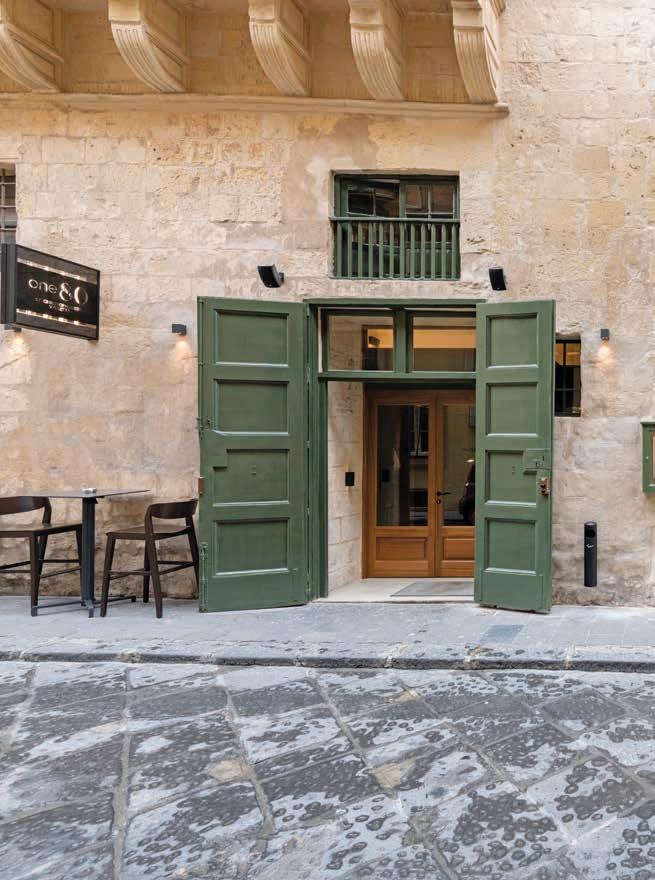
In designing the look of the facade, KEIRO Architects were sensitive to the feel of the street and neighbouring building. Classic vintage green was chosen for the doors. Security and safety for the project was of paramount importance and a key consideration in design. Masco Security Services Ltd installed discreet-looking technology to provide high quality security solutions, including intruder alarms and CCTV, as well as fire alarm systems.
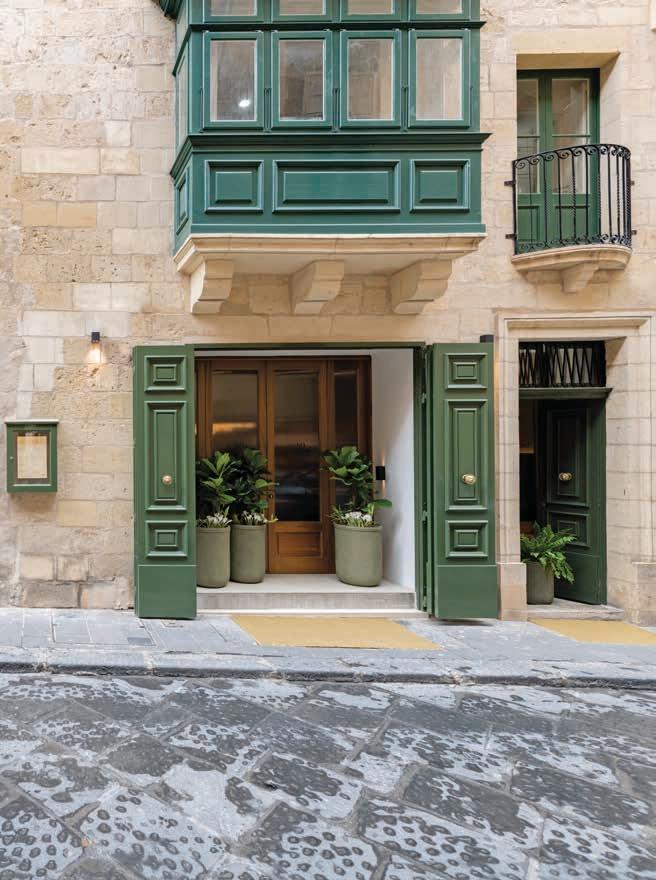
Palazzo Spinola in Valletta first came into the Spinola family in 1660 when Fra Paolo Raffaele Spinola, an Italian knight of the Order of St. John, acquired it from Fra Giovanni de Villaroel. Around the turn of the 20th century, the palace was divided into three parts. The parts facing what is now Republic Street and Frederick Street were taken over as offices and a private residence, and the third part facing St Christopher Street was replaced with a block of flats, its façade studded with wooden apertures and traditional closed wooden galleriji

Recently, KEIRO Architects transformed a 140sq metre space nestled within Palazzo Spinola using natural and versatile materials to fulfil the owners’ vision for a laid-back venue with a timeless, impeccable style. The project won the Public Vote Award in the 2022 MASP awards, which took place earlier this year. The interior is a pleasant and welcoming seting with a hint of green echoing the colour of many of Valleta’s traditional closed balconies. Its distinctiveness and originality was realised through an ensemble of curved wood, natural stone, cold black metals, and translucent ribbed glass, while creatively extracting the needed functionality through design and choice of material.
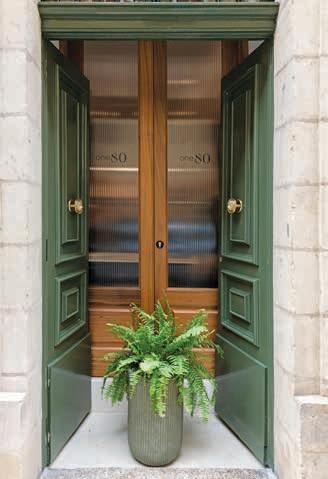
One of the aims of the project was to restoe and beautify elements that where already present within the space.


Thedesign strikes a balance between casual and luxury dining, with a layout strategically planned to include reception, waiting, and dining areas for patrons, while maximising the commercial potential for seating and accommodating the functional needs of a commercial restaurant, not least its kitchen and stores.
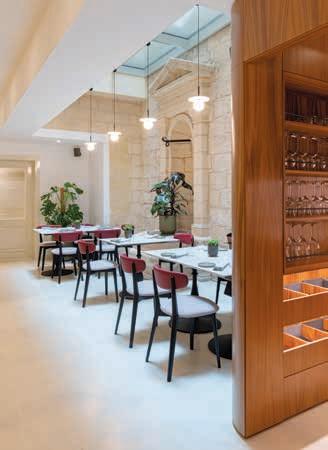
The aim of the project was to restore and beautify the elements that where already present within the space. The floor tiles, for example, were sanded down and given a resin coating for a new lease on life. The apertures were carefully restored by traditional master crafsmen, while the existing gypsum works were modified and given a new purpose. Natural materials such as wood and stone dominate physically and visually. “This sustains the energy of the heritage architecture, which was fundamental in transforming this space in pure Maltese style,” say KEIRO Architects.
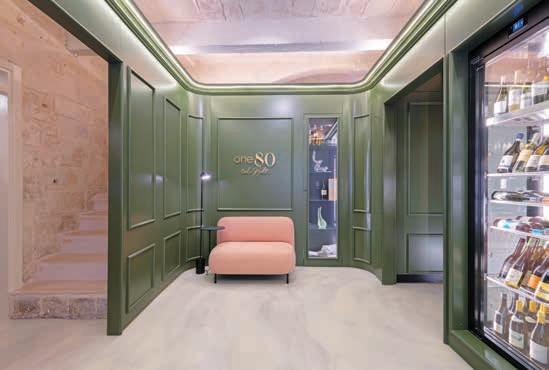
Contemporary fixtures and fittings were installed with all wiring and plumbing systems tucked away out of sight.
EPM Solutions Ltd provided general electrical and plumbing services and modified the existing gypsum plastering.


Although the space is located within a historic building, the sense one has upon entering is of being in a familiar traditional Maltese townhouse, an experience conveyed by elements such as the traditional green tones of the wooden doors with their gleaming brass knockers in the shape of a lion’s head, and the welcoming feel of a antiporta that is visible from the street, a classic feature of traditional stone townhouses that is now, more ofen than not, kept hidden from view behind closed front doors.
The curved wooden fittings and panelling are a subtle homage to the curved balcony of the Grandmasters’ Palace’s located just up the road. The colours of the interior are easy on the eye, promoting a sense of warmth, comfort, and tranquility. The hint of green, the redness of the wood and the natural tone of the stone form a colour and texture palete that is warm and welcoming, yet refreshing to the senses, and which invites diners to relax and engage with their ambiance.
The slick look of the interior is enhanced by table tops in cool smooth marble from Desana Marbles who also supplied the material for the countertop and backsplash in the waiter’s station. The table legs are by Spiteri Catering who also supplied the restaurant chairs, as well as the benches and wine coolers.

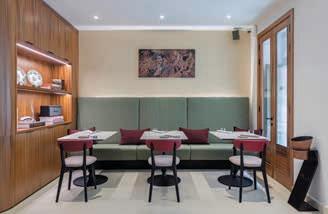
The curved wooden fitings and panelling are a subtle homage to the curved balcony of the Grandmasters’ Palace’s located just up the road.

Botanical print wallpaper adds visual interest. Its greenery echoes the colour accents found throughout the interior and complements the soft-toned palette of the restrooms. The sanitary ware and accessories were supplied by Farell Bathrooms.

Thelighting can be adjusted to create an intimate, restful atmosphere at any hour of the day. The simple quality detailing in the lighting fixtures and furnishings complements the space, providing a luxury finish with a sense of richness befitting the building’s historic context. The custom-made perforated wood cladding and textured wallpaper are visually pleasing and also function as sound absorbers, eliminating the echoing problem that was identified from the start of the project.
“The interior concept which was first put on paper and then recreated through timeless materials, always held the patrons at its core, whether visiting during the morning or in the evening,” say KEIRO Architects. “It is a space which morphs from a daytime eatery to a refined dining room just by adjusting the lighting atmosphere.”


Natural materials such as wood and stone dominate physically and visually.

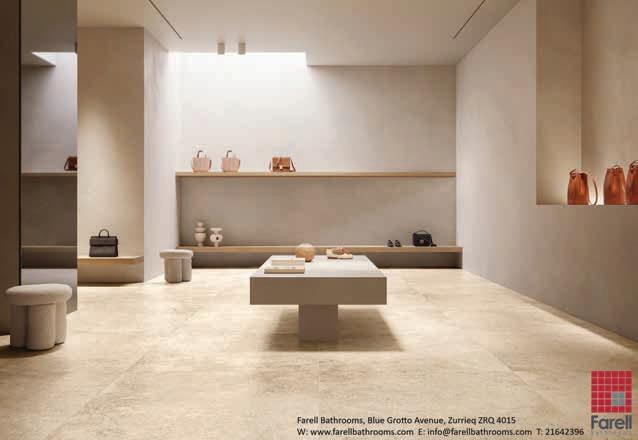

Architecture, restoration, and structural engineering:

APValleta creative cluster, a series of spaces over multiple floors linked by a central courtyard, is a creative hub dedicated to the cultivation of new ideas in Valleta. “The idea of bringing together creative enterprises next to each other is to stimulate them as drivers for urban regeneration and innovation,” says AP executive director, Konrad Buhagiar. The cluster is designed to be fully integrated within its urban surrounding and historical context, and to develop and grow within the context of Valleta as a creative city, based on connecting or catalysing cultural enterprises as a value chain.
The creative cluster is designed to be fully integrated within its historical context and urban surroundings. The historical building that forms part of the cluster is the only one in the area to retain its original aspect.The ironwork on the facade was meticulously restored by Charles Darmanin Forged Wrought Iron Works. Photo: AP Valletta



Charles Darmanin Forged Wrought Iron Works is a family-owned business specialised in bespoke iron works for both domestic and commercial projects. Quality, functionality, and aesthetics are at our core. From rustic and heritage looks, to modern and sleek, if you can imagine it, we can design and make it.





The elegant combination of materials such as wood, travertine, and concrete shores up the quality and lightness of the space.

The design of the creative cluster focused on the preservation of the spirit that has always differentiated AP and its team. It involved the integration and realignment of several buildings into a coherent whole and the development of an extension at roof level. The restoration and design process were backed by extensive research and sensitivity to the building’s World Heritage context, earning the project a special commendation in the 2022 MASP Awards held earlier this year.
As part of the regeneration project, the architecture firm restored and renovated its historical building which is situated on St. Michael’s Bastion, part of the enceinte of the fifteenth century on Valletta’s Western land front, overlooking the entrance to Marsamxett Harbour. An underlying tunnel runs along its length, connecting Sappers Street to the fortified ditch that surrounds Valletta.
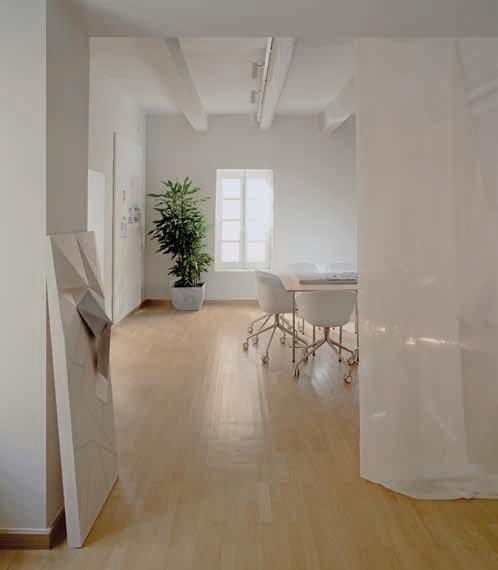
“
T e idea of bringing toge ter creative enterprises next to each o ter is to stimulate tem as drivers for urban regeneration and innovation”
TRIBÙ, THE ART OF LEISURE

For Tribù luxury is discreet, contemporary and understated - elegant details and subtle colours, shapes and textures that work in harmony with their setting, offering that little something extra that elevates design from the ordinary to the extraordinary.
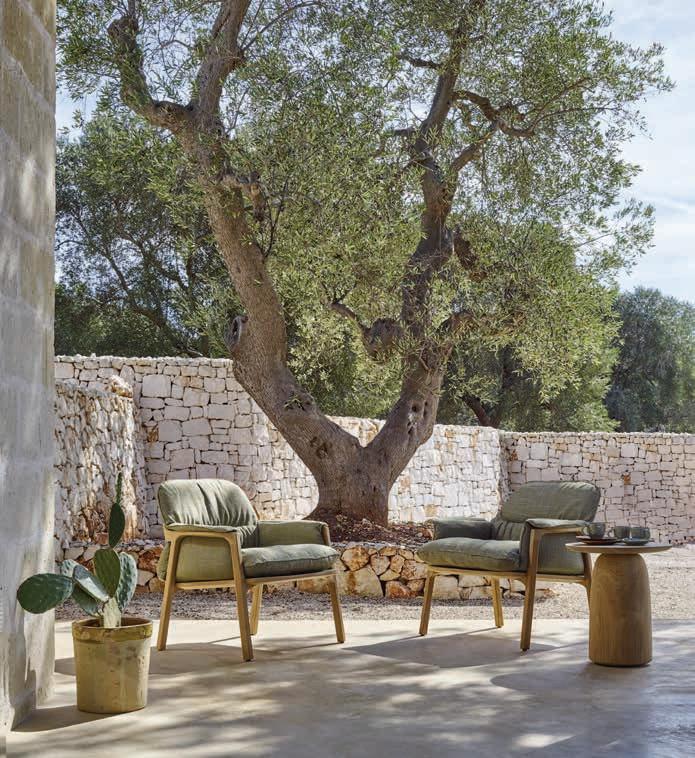
The original seventeenth century fabric of the building was considerably tampered with during the nineteenth century. During the Crimean War, when Malta served as headquarters for the Allies, an unrealised project for a military hospital on the bastion, led by Florence Nightingale, incorporated this building to serve as the entrance wing. In spite of its history, this is now the only building in the area to retain its original aspect, as most of its surroundings have been redeveloped in the eclectic style of the period.
In the restoration phases of the project, most of the existing fabric of the historical building was restored and reused in a process that demanded great care for its delicate elements. Several deteriorated stone blocks in the masonry structure had to be replaced to reintroduce the structural integrity of the building envelope and the visual legibility of the decorative elements.
The six-storey cluster at 4, Sappers Street now surrounds a central courtyard that was developed as a communal yet private area that harmonises the elements of solid and void of the space and functions as a communication element between all parts of the building. The courtyard brings in natural light and enables natural ventilation that removed the reliance on mechanical ventilation, part of the raf of new measures that reduce the regenerated building’s overall environmental impact.
The relaxed style of the training room encourages creative interaction.



In the design office, the colour and organic forms of leafy plants have a soothing effect. While the building enjoys natural ventilation through the courtyard connecting its different spaces, on the hottest days, climate control is managed through air conditioning supplied by Panta.

Thermal break apertures have been installed in the courtyard and doubleglazed units installed on all external apertures. The existing wells have been restored and are now used to collect rainwater that irrigates the planter and landscaping in the building and in the nearby public piazza, as well as to flush the toilet in the building’s common areas. An energy efficient centralised system has replaced all the air-conditioning units, and LED lighting has replaced the previous lighting system.
A soft palette enhances the lightness of the interior. Lighting fixtures supplied by Elektra are discreet and positioned throughout the building to be visually unobtrusive.
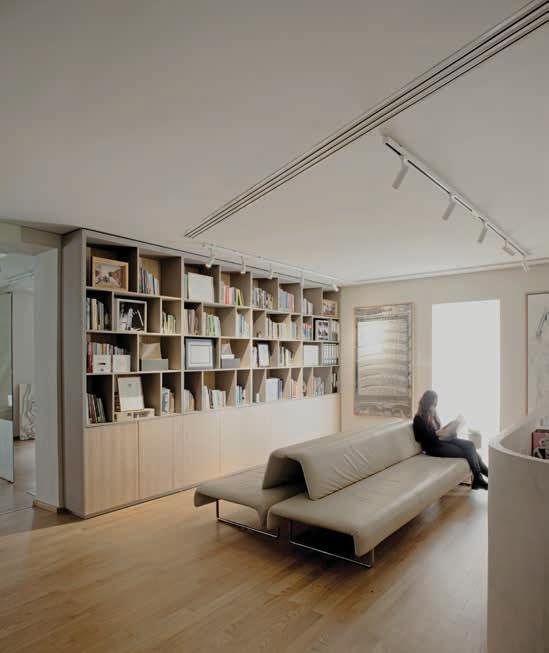
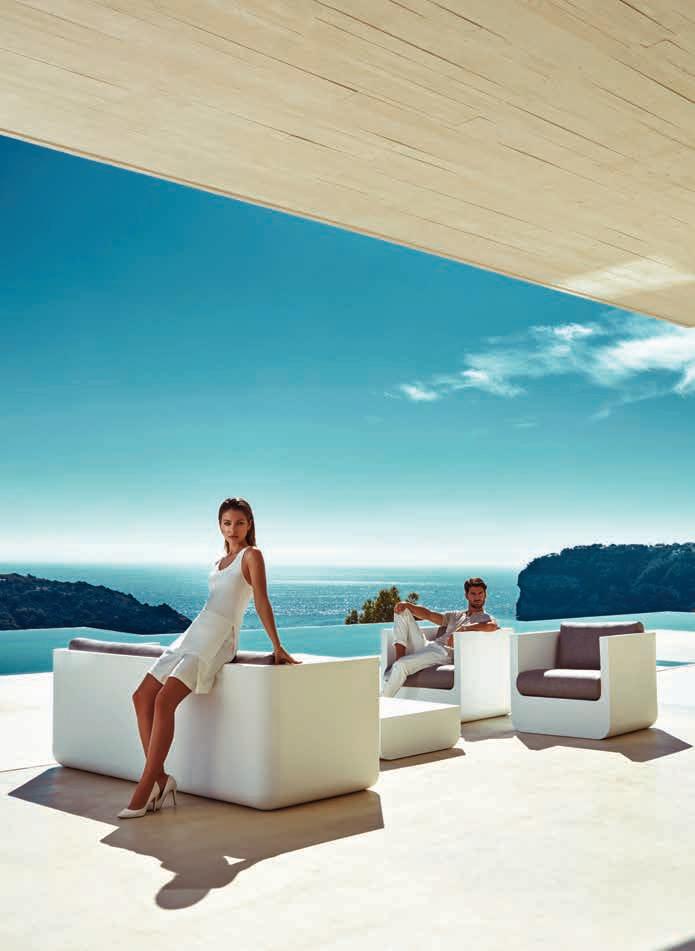
Openness and transparency mould both the working and the recreational areas. The elegant combination of materials such as wood, travertine and concrete shores up the quality and lightness of the space. On the ground floor shared by all the tenants of the creative cluster, the kitchen and lounge area serve as a welcoming and networking space where people can take time to relax and build relationships, promoting cooperation and cultural exchange among the different creative entities and their guests.
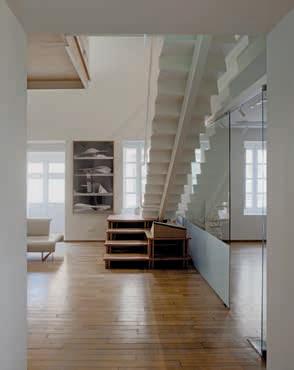


During te Crimean War, an unrealised project for a military hospital on te bastion, led by Florence Nightingale, incorporated tis building.


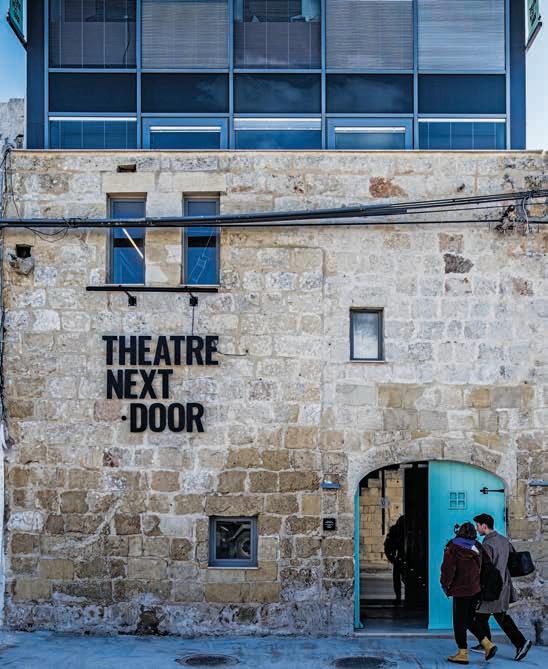
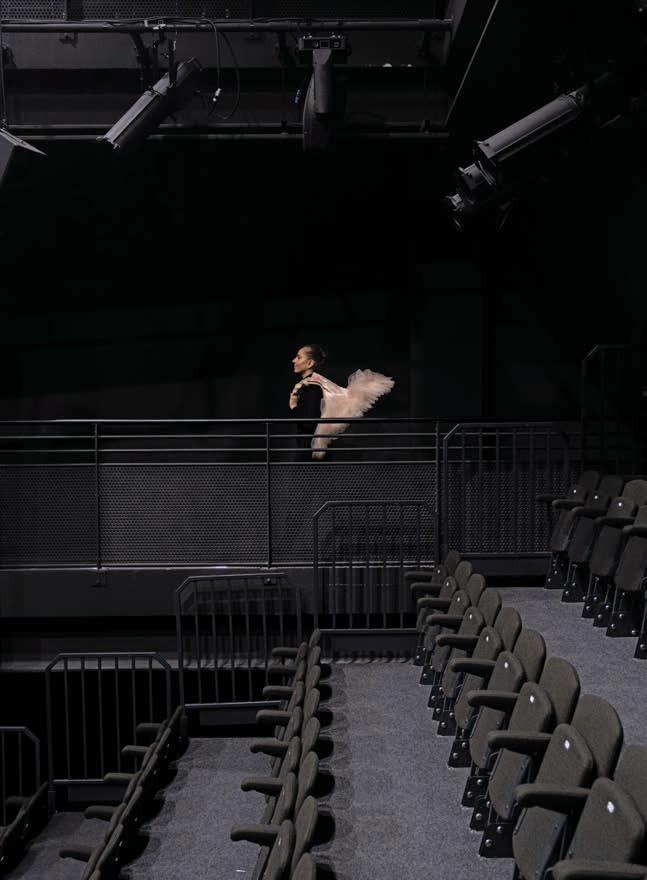
In addition to the theatre auditorium, the regenerated building includes three multipurpose/rehearsal studios, where double-glazed apertures enable efficient internal climatecontrol. The apertures are from Finestral who also supplied the theatre's office partition, shaft windows and doors.


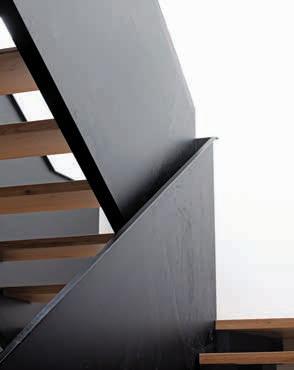
he owners of the performing arts school, Stagecoach Malta, had already initiated the project and wanted to engage a design firm. “Edward and Marika Mercieca contacted us. The disused farm was next to their family home in Maghtab. Their daughter had interned with us some years ago. They liked our approach,” says Keith Pillow, the founder and creative director of DAAA Haus. “Edward’s a creative person himself and, when we met, we clicked straight away. Rather than immediately talking about the layout of the building and the allocation of space, we began talking about the concept for the theatre.”
DAAA Haus worked with the Mercieca family and their architects, Joseph Cassar & Associates, to design a building that is contemporary but true to its context. Unusually, DAAA Haus took on the task of managing the project too, a role that is not usually within the firm’s remit, but one which enabled it to ensure all aspects of the development were completed on schedule despite the short deadlines. Lots of people had lost jobs in hospitality because of the lockdown and restrictions on travel, so the firm engaged experienced staff to help manage the project, which lasted as long as it took for the hospitality sector to reopen – a win-win solution at a challenging time.
The fabric-covered Flos chandelier from Elektra has the feeling of a ghost lamp, evoking the spirit of the Phantom of the Opera, a byword for musical theatre.
The “black box” theatre completely excludes natural light, focussing audience attention on the performance. Sergio Costa on behalf of Costa Consulta Ltd designed the theatre and Theatre Next Door’s audio visual design.

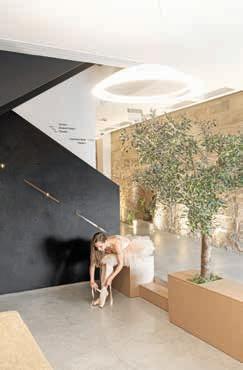

he timelines were short and, when the September and October rains began, the structure wasn’t closed yet,” Keith Pillow says. “Though not without problems, everything came to completion as planned. We handed over the project in springtime 2022, 18 months afer we started.”



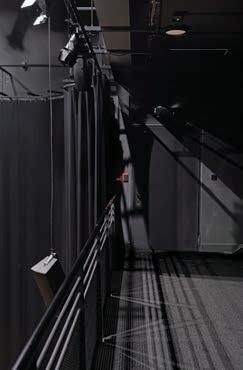
The transformation from farm to theatre is striking. A bridge now connects the main building on the street with the “back of house” building behind it. From there, a large external spiral staircase provides a mandatory safe route out of the building. Inside, apart from the main theatre, there are three multipurpose/rehearsing studios for performing arts, changing rooms and costume rooms. There’s a café zone on the ground floor and a roof terrace café where patrons can enjoy open views of the surrounding fields during breaks in performances, or where performers and students can enjoy a break-out session during their rehearsals or classes.

It’smagic.Andlikeallgoodmagic,itworkseverytime.
Seenfromdownhere,themoonhasathousandnuances.Whenfull, itbringsjoytothosewhowatchitturn.Moonwascreatedfromthe dreamofbringingthemooninsideyourownhome.ThehandmadeJapanesepapersurfacemakeseverylampunique.

ayfinding signage was planned in with the building design to be very clear but unobtrusive. Interventions are minimal and the overall look is light, bright, and clean. Some of the features of the original building have been retained, including most of the keleb and xorok and some of the original pig troughs, in the theatre’s café zone downstairs, the oldest room in the building. Light, always a significant factor in architecture and design, is particularly important in a theatre building. Natural light floods in through a skylight set into the roof and cascades down the building’s interior through glass panels set into the floor on every level. In the main theatre, the technical challenge was the opposite. It incorporates sound and light engineering, was designed as a black box that so natural light and reflections had to be excluded altogether. It took several coats of paint to achieve total blackness.





e tried to keep the design throughout very clean. It is in our usual language, a mix of old and new. We never replicate or fake history,” Keith Pillow says. “The reception area is representative of our approach.” The materials of the reception counter – rough stone with a backdrop of Corten steel – are raw and suggestive of the building’s seting in Maghtab with its associated quarries and scrapyards. A preserved olive tree complete with olives – which looks impressively real – appears to grow out of the bench separating the hall space from a ramp that enables access to all abilities. It gives a sense of the rural farm that the space once was, and can be seen as a symbol of the wider Mediterranean context. The fabric-covered Flos chandelier has the feeling of a ghost lamp, evoking the spirit of the Phantom of the Opera, which has become a byword for musical theatre.
Overall, the combination of materials, space, and lighting throughout Theatre Next Door is timeless and will age well, providing a clean canvas for performance to take centre stage, literally and figuratively.
Safety and security features are critical in a building with public access. Fire-proof doors supplied by Vivendo are one of the safety features discreetly integrated into the building design. Uplighters set into the floor highlight the textured surface of the old stone wall, creating a theatrical backdrop in the reception area. Elektra supplied the general lighting system throughout the theatre building.

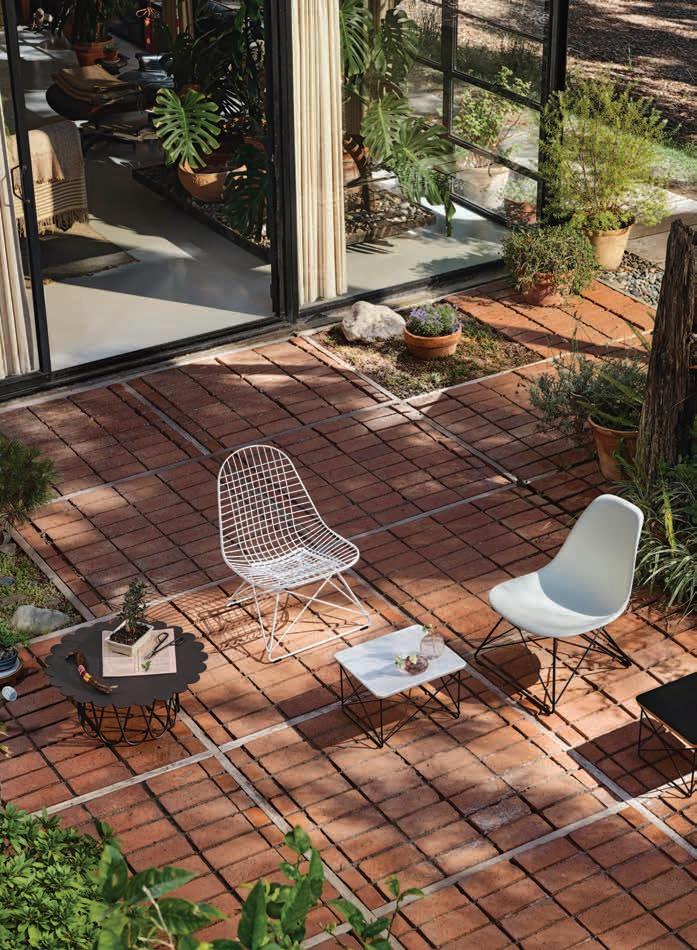
Elegance lives here! The Modo bookcase/TV unit by San Giacomo is fitted with storage units & glass cases: all this in a composition with great appeal and function. Its design is understated yet distinct. The finishes speak a sophisticated language made up of attractive lacquer finishes, precious natural wood and transparent glass surface. Available on display at Satariano, 122 Msida Valley Road, Birkirkara.

With the New Classics collection, Orac Decor offers refreshing and simple ways to give classical grandeur to today’s interiors. Panelling, cornice mouldings, accompanying skirting boards and indirect lighting: create your classic interior with a contemporary look and feel. Modern technology and a sustainable approach lay the foundations for these new classics, whilst respecting tradition. Smart product design and state-ofthe-art technology also guarantee the best quality. Find Orac Decor at Brands International, Triq tal-Balal, San Gwann. www.brands.com.mt

Possibly the Best Barbecues in the World! Every Broil King gas grill is built to provide unparalleled cooking versatility. No matter what model you choose, the legendary Broil King cooking system gives you the ability to cook almost anything on your grill in any style you desire. You can sear steaks to perfection, rotisserie cook poultry or roasts, and even bake elaborate desserts. Broil King - great barbecues every time! Large selection available from Satariano, 122, Msida Valley Road, Birkirkara.

Artemide's newest outdoor lighting collection, Knop, features simple geometric shapes and carefully selected finishes, designed to blend seamlessly into outdoor environments and interact with nature. With three bollards of varying heights and a wall-mounted version, the collection is versatile and can mark paths or create large illuminated areas where people can linger. The geometry of the collection is perfect for reflecting nature and keeping the bollard head clean. Exclusively available at ESS Ltd., San Gwakkin Road, Birkirkara. www.ess.com.mt

Naturally True. Landstone by Novabell Ceramiche a ceramic stone inspired by limestone surfaces, enhanced and customised with tactile effects that achieve a chromatic balance, making it very versatile to use. Available from Satariano, 122 Msida Valley Road, Birkirkara.
For advertising, contact Sean Ellul on +356 7921 0705 sellul@independent.com.mt The next issue will be out in June 2023 with The Malta Independent on Sunday.


